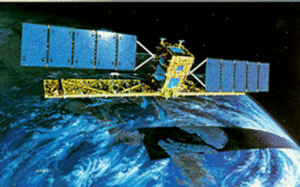 RADARSAT-1 satellite | |
| Mission type | Earth observation |
|---|---|
| Operator | Canadian Space Agency |
| COSPAR ID | 1995-059A |
| SATCAT no. | 23710 |
| Website | www |
| Mission duration | 5 years (planned) 17 years, 4 months, 24 days (achieved) |
| Spacecraft properties | |
| Bus | RADARSAT |
| Manufacturer | MDA (formerly Spar Aerospace) Ball Aerospace |
| Launch mass | 2,750 kg (6,060 lb) [1] |
| Power | 2.1 kW |
| Start of mission | |
| Launch date | 4 November 1995, 14:22 UTC |
| Rocket | Delta II 7920-10 |
| Launch site | Vandenberg, SLC-2W |
| Contractor | Boeing |
| End of mission | |
| Last contact | 29 March 2013 |
| Orbital parameters | |
| Reference system | Geocentric orbit |
| Regime | Low Earth orbit |
| Perigee altitude | 793 km (493 mi) |
| Apogee altitude | 821 km (510 mi) |
| Inclination | 98.60° |
| Period | 100.70 minutes |
RADARSAT-1 was Canada's first commercial Earth observation satellite. It utilized synthetic aperture radar (SAR) to obtain images of the Earth's surface to manage natural resources and monitor global climate change. As of March 2013, the satellite was declared non-operational and is no longer collecting data.
- ^ "Satellite Characteristics". Canadian Space Agency. 21 January 2011. Retrieved 20 October 2014.